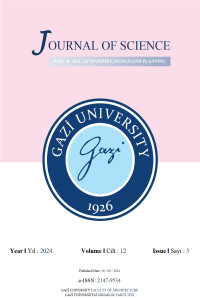Abstract
References
- [1] Bakkal, S. ve Alkan, M., 2008 Finansal Krizi ve Bu Dönemde Bankacılık Sektörünün Kar Etme Nedenleri. İstanbul: Hiperlink Yayınları, 65-69, 2011.
- [2] Özcan, Ö. Türkiyedeki Banka Binalarının Mimari Mekan Ve Büro Tasarım Kriterleri Açısından Değerlendirilmesi, Doktora Tezi: İTÜ Fen Bilimleri Enstitüsü, İstanbul, 2002.
- [3] Yüzgün, A. (1983). Türk bankacılığının tarihsel gelişimi. Cumhuriyet Dönemi Türkiye Ansiklopedisi, 1, 155-170.
- [4] Tekeli, İ., & İlkin, S. 1929 Dünya Buhranında Türkiye'nin İktisadi Politika Arayışları (Vol. 1). Bilge Kültür Sanat, 2009.
- [5] Delice, G. Türkiye Cumhuriyet Merkez Bankası: 85 Yıllık Bir Geçmişin İzlerinden Tarihe Kayıt Düşmek. Ekonomi İşletme Siyaset ve Uluslararası İlişkiler Dergisi, 1(2), 21-55, 2015.
- [6] Uluyol, O. 1980-2000 Döneminde Türkiye’de Bankacılığın Gelişimi. Muhasebe ve Finans Tarihi Araştırmaları Dergisi, (17), 73-107, 2019.
- [7] Çımrın, F. K. Küreselleşme, Neo-Liberalizm ve Refah Devleti İlişkisi Üzerine. Muğla Üniversitesi Sosyal Bilimler Enstitüsü Dergisi (23), 195-204, 2009.
- [8] Hasol, D. 20. Yüzyıl Türkiye Mimarlığı. İstanbul: Yem Yayınları, 35-267, 2020.
- [9] Şener, M. Cumhuriyet’in İlk Yıllarında Ziraat Bankası Ve İş Bankası Hizmet Binaları: Milli Mimarlık Ve Banka Yapıları. Tarih ve Uygarlık-İstanbul Dergisi, vol.1, no.9, 205-226, 2016.
- [10] Sözen, M., & Tapan, M. 50 Yılın Türk Mimarisi. İstanbul: Türkiye İş Bankası Kültür Yayınları, 193-197, (1973).
Abstract
Architecture has been affected by cultural, social, political and economic changes throughout history. The architecture of the Republican period is dominated by concepts such as traditionalism, Turkism, functionality and locality. In this process from the proclamation of the Republic to the 21st century, the search for identity in architecture can be analysed in three periods. The years between 1910-1930 are the First Nationalist Architecture in which Ottoman and Seljuk references are used under the influence of nationalist ideas. In the 1940s, the period of II. Nationalist Architecture, in which traditional elements were used, began. In the 1960s, architects interpreted local identity with modern language. In this 60-year period, architects are in search of an intersection between modern architecture and local architecture. After 1980, the changing political process and the global economic strategies adopted by Turkey changed the socio-cultural structure of the country. In this context, Turkish architects have also been affected by the global architecture that affects the whole world. The international architecture that emerged as a result of globalisation is a modern language that is far away from the place and its context, in which postmodern and minimalist movements started to dominate. In this period, the construction investments made by banks, which have a significant capital in Turkey under the influence of globalisation, were influenced by this postmodern architectural language. Important architects of the period designed the multi-storey buildings reflecting the corporate identities of financially strong banks. Therefore, the best examples of the architectural language of the period in Turkey are bank buildings. After 2000, with the changes in building supervision and the development of computer-aided design, building construction systems and high-rise building examples have developed. Within the scope of the study, multi-storey bank buildings designed by prominent architects of the period between 1980-2000 were investigated. Examples of bank buildings in Istanbul, Ankara and Izmir are compared by examining their architectural style, spatial organisation and their relationship with the city. It is revealed how these buildings were shaped as a synthesis of global architectural trends away from local architecture. In these examples, the effort of the bank buildings to be symbolic and prestigious buildings is seen in the façade structural elements, façade formations and material usage.
References
- [1] Bakkal, S. ve Alkan, M., 2008 Finansal Krizi ve Bu Dönemde Bankacılık Sektörünün Kar Etme Nedenleri. İstanbul: Hiperlink Yayınları, 65-69, 2011.
- [2] Özcan, Ö. Türkiyedeki Banka Binalarının Mimari Mekan Ve Büro Tasarım Kriterleri Açısından Değerlendirilmesi, Doktora Tezi: İTÜ Fen Bilimleri Enstitüsü, İstanbul, 2002.
- [3] Yüzgün, A. (1983). Türk bankacılığının tarihsel gelişimi. Cumhuriyet Dönemi Türkiye Ansiklopedisi, 1, 155-170.
- [4] Tekeli, İ., & İlkin, S. 1929 Dünya Buhranında Türkiye'nin İktisadi Politika Arayışları (Vol. 1). Bilge Kültür Sanat, 2009.
- [5] Delice, G. Türkiye Cumhuriyet Merkez Bankası: 85 Yıllık Bir Geçmişin İzlerinden Tarihe Kayıt Düşmek. Ekonomi İşletme Siyaset ve Uluslararası İlişkiler Dergisi, 1(2), 21-55, 2015.
- [6] Uluyol, O. 1980-2000 Döneminde Türkiye’de Bankacılığın Gelişimi. Muhasebe ve Finans Tarihi Araştırmaları Dergisi, (17), 73-107, 2019.
- [7] Çımrın, F. K. Küreselleşme, Neo-Liberalizm ve Refah Devleti İlişkisi Üzerine. Muğla Üniversitesi Sosyal Bilimler Enstitüsü Dergisi (23), 195-204, 2009.
- [8] Hasol, D. 20. Yüzyıl Türkiye Mimarlığı. İstanbul: Yem Yayınları, 35-267, 2020.
- [9] Şener, M. Cumhuriyet’in İlk Yıllarında Ziraat Bankası Ve İş Bankası Hizmet Binaları: Milli Mimarlık Ve Banka Yapıları. Tarih ve Uygarlık-İstanbul Dergisi, vol.1, no.9, 205-226, 2016.
- [10] Sözen, M., & Tapan, M. 50 Yılın Türk Mimarisi. İstanbul: Türkiye İş Bankası Kültür Yayınları, 193-197, (1973).
Details
| Primary Language | English |
|---|---|
| Subjects | Architectural Heritage and Conservation, Architectural Design |
| Journal Section | Architecture |
| Authors | |
| Publication Date | September 30, 2024 |
| Submission Date | March 31, 2024 |
| Acceptance Date | July 31, 2024 |
| Published in Issue | Year 2024 Volume: 12 Issue: 3 |


